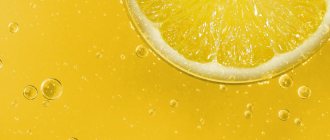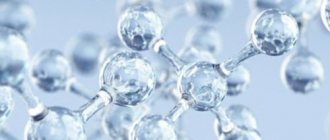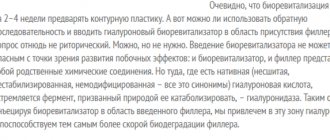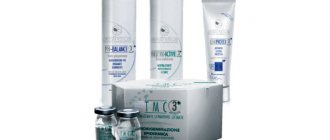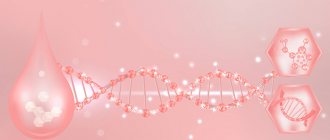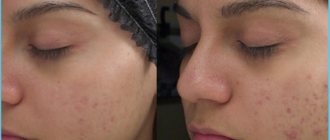What does acid treatment include?
Acid treatments involve exfoliating the top layer of skin using chemicals called hydroacids. They irritate the skin and damage epidermal cells, enhancing their regeneration. Acid treatments are designed to improve skin condition and reduce signs of aging - wrinkles and discoloration, as well as treat acne scars.
Acid peeling was known already in ancient times. Women used lactic acid for the face (in the form of sour milk) and grape, lemon or apple cider vinegar. These at-home chemical peels, however, did not always produce good results - their incompetent use led to bacterial infections and scarring during healing.
In modern cosmetology, acid treatments are carried out using alpha and beta acids, which, at concentrations below 5%, do not irritate the skin and provide a slight exfoliation effect.
Treatment using hydroacids stimulates epidermal renewal processes and can be used for all skin types. However, people with sensitive skin should choose lower concentration hydroxy acids.
Fruit acids in lower concentrations affect the skin primarily by moisturizing and regenerating, while fruit acids in higher concentrations cause exfoliation of the epidermis and restoration of a new superficial layer of skin.
Indications for use
What does almond peeling do and when is it necessary? Indications for exfoliation are very diverse. The procedure helps to cope with the shortcomings of both young skin and aged skin in need of hydration and regeneration.
Often, phenoxyglycol exfoliation is performed as an alternative to hardware or manual facial readings.
Exfoliation with mandelic acid solves the following problems:
- acne of the first and second degree;
- post-acne, stagnant spots;
- pigmentation, freckles;
- oily, unclean skin;
- enlarged pores;
- folliculitis;
- rosacea;
- uneven complexion;
- keratosis;
- the first signs of aging.
In addition, almond exfoliation is often prescribed in preparation for serious cosmetic procedures, such as deep and medium peels, laser resurfacing. Manipulation allows you to even out the thickness of the epidermis, reduce possible complications and improve the final result.
Types of cosmetic acids
Acid peeling is used to improve the appearance and condition of the skin, as well as improve skin tone. Cosmetic acids can be used for both dry and oily skin. When used correctly, the acid deeply moisturizes the skin, removes dead and damaged epidermal cells, stimulates cells in the deeper layers of the skin to restore the epidermis, making it smoother and the signs of aging less noticeable.
During acid treatment, the most commonly used acids are lactic, mandelic, citric and glycolic acids.
Acid peeling - before and after
Types of acids used in cosmetology:
- Alpha hydroxy acids (AHAs).
They have a moisturizing effect and stimulate the metabolism of skin cells. Treatments with fruit acids are recommended for dry, pale skin with acne. The group of alpha hydroxy acids includes: lactic, glycolic, citric, malic, tartaric and mandelic acids. - Beta hydroxy acids (BHA).
They have moisturizing, exfoliating, anti-inflammatory, whitening and antioxidant properties. They are recommended for pale skin with acne and signs of aging. At higher concentrations, these acids are irritating and may cause sensitization. The most commonly used BHA is Salicylic Acid. - Polyhydroxy acids (PHAs).
They have a moisturizing, anti-inflammatory and antioxidant effect. They are gentler than alpha hydroxy acids and non-irritating, making them suitable for tired, sensitive skin with discoloration and signs of aging. Examples of polyhydroxy acids are gluconolactone and lactobionic acid.
Answers on questions
Why did I get acne after almond peeling?
The appearance of acne after phenoxyglycol exfoliation is not considered normal and indicates either non-compliance with the protocol and violation of post-peeling care, or hormonal imbalances in the body. The second reason is much more common. Endocrine disorders in this case become a provoking factor for disruption of seboregulation of the skin weakened by peeling.
In addition, acne may appear due to an allergic reaction caused by the components of the exfoliant. Another cause of painful rashes can be simple failure to comply with hygiene rules during the procedure.
Almond, glycolic or milk peeling – which is better?
Phenoxyglycolic acid has all the qualities of fruit enzymes, but if we take the same concentrations of these substances as a sample, then, other things being equal, almond peeling acts more delicately, practically does not cause side reactions and is suitable even for sensitive and thin dermis. In addition, phenoxyglycol exfoliation is safe for dark skin and can be performed during periods of high solar activity.
If we talk about milk exfoliation, it is not much different from almond exfoliation. The procedure also does not cause photosensitivity, that is, it can be performed in the summer and is completely safe for people with dark skin. True, lactic acid has a smaller molecule, so it penetrates tissue more easily and is more likely to cause allergies. Lactic acid should not be used for rosacea.
Each of the peelings discussed is good in its own way. Therefore, only a specialist can decide which one is better, based on the condition of your skin and the expected effect.
Who is recommended for 40% almond peeling?
Almond exfoliation can be used not only to brighten and smooth the skin, but also for rejuvenation purposes. It is in this case that a 40 percent acid concentration will be most effective. In addition, an exfoliant with a high content of active substances copes better with acne, providing an antibacterial effect. The higher the concentration of the solution, the more powerful the antimicrobial effect.
Is it possible to do peeling during menstruation?
Most cosmetologists agree that it is undesirable to perform acid exfoliation during menstruation. At this time, blood clotting noticeably deteriorates, which can lead to persistent redness of the treatment area and even the development of hematomas. There is also a more frequent occurrence of edema.
Many women say that a session performed during menstruation is characterized by unpleasant sensations, while procedures performed at other times are not painful and without significant discomfort.
What are the contraindications to the procedure?
Even taking into account the fact that phenoxyglycol exfoliation is the most delicate and gentle, not every woman can do it. There are a number of contraindications that limit the use of peeling.
Among them:
- exacerbation of the herpes virus;
- hypersensitivity to exfoliant ingredients;
- wounds and damage in the exfoliation area;
- fresh tan;
- recent laser skin treatment.
Pregnancy and breastfeeding are not always a contraindication to almond cleansing. A weak concentration of the solution is unlikely to have an adverse effect on the health of the expectant mother and baby. Still, pregnant and lactating women should consult a doctor before the procedure.
Effect of acids for chemical peeling
Each acid gives specific effects and requires a different recovery period after peeling:
| Acid | Result |
| Glycolic acid | Exfoliates and regulates the thickness of the top layer of skin and its color. Stimulates skin cells to synthesize collagen, thereby increasing its elasticity. With regular use, every 10-14 days, wrinkles become less noticeable. Exfoliation after using glycolic acid lasts 2 to 3 days. The skin turns red after peeling, and a burning sensation may also occur. After this time, the skin begins to regenerate, creating a new epidermis. |
| Mandelic acid | Stronger than lactic acid. Has an exfoliating and bactericidal effect. Can be used for all skin types. Also suitable for sensitive skin as it does not cause irritation. Effective for eliminating hyperpigmentation and acne scars. It also regulates sebum secretion and makes skin pores less noticeable. |
| Lactic acid | Has a moisturizing and exfoliating effect. |
| Lemon acid | In addition to exfoliating, it also has brightening properties. |
| Salicylic acid | The most popular beta hydroxy acid. It is gentler than fruit acids, but also exfoliates, moisturizes and restores the skin. |
| Hyaluronic acid | Used for procedures that moisturize the skin. In high concentrations it causes peeling of its top layer. Treatment with hyaluronic acid does not cause irritation, so it can be used for sensitive skin. |
| Alpha keto acids (AKAa), such as pyruvic acid. Polyhydroxy acids, for example gluconic and lactobionic acids. | They have a rapid superficial irritant effect, causing the skin to exfoliate and then recover. In addition, these acids have a brightening, anti-acne and bacteriostatic effect. |
| Pyruvic acid | Recommended for sensitive skin with signs of photoaging, discoloration and acne scars. |
| Azelaic acid, found in cereals. | It has a multidirectional effect and is used to treat seborrheic dermatitis, juvenile and rosacea, acne and papulopustular lesions. It has anti-inflammatory properties and blocks melanin production. Like other acid treatments, azelaic acid peels are recommended for skin with visible signs of aging. |
Possible complications
The gentle effects of peeling and specially created formulas do not guarantee the absence of adverse effects.
The most common complications are:
- swelling of treated tissues;
- allergic rash caused by intolerance to the components of the exfoliant;
- exacerbation of herpes;
- increased sensitivity;
- dryness, burning and tightness;
- redness.
The effects discussed above occur very rarely and, as a rule, are the result of poor preparation for exfoliation or non-compliance with the exfoliation protocol.
Reviews from cosmetologists about the procedure
Cosmetologists and dermatologists speak only highly of almond cleansing. Positive ratings note the delicacy of the process, the possibility of use for dry, thin and sensitive skin.
After the first session, cosmetologists see how fresh and prettier the patient is. Sluggish and dull skin is filled with energy, becomes healthy and elastic, the tone and texture of the face is evened out, and post-acne marks are reduced. However, experts warn that phenoxyglycol exfoliation is only effective up to age 35.
Almond peeling will not eliminate excess sagging skin, deep wrinkles and other age-related changes. In this case, more serious cosmetic procedures will be required.
How is acid peeling done and how long does it take for the skin to heal?
Acid treatments are carried out either using one acid in the right concentration, or by mixing different types of acids. Acid peeling should be performed by an experienced cosmetologist, as the type and concentration of acid should be selected individually for the patient's skin.
Two weeks before the procedure, it is recommended to use a cream with a hydroxy acid, such as glycolic. This cream should also be used after the procedure.
Before the procedure, the cosmetologist protects areas of the facial skin that should not come into contact with acid, that is, around the eyes, lips and wings of the nose. Then the drug is applied to the skin with a brush and left for a time calculated by the doctor. The individual skin reaction is preliminarily checked.
The next stage is to neutralize the acid with a special preparation and leave it on the skin for several minutes. After this time, wash your face with warm water. Next, the cosmetologist applies a nourishing mask for 30
Acid treatments require the use of high UV filter creams and a protective cream for sensitive skin for at least 3-4 weeks.
The acid treatment should be repeated after approximately 14 days.
Facial care after the procedure
The first two sessions are recommended to be carried out in the salon (especially for those with sensitive skin), and then home care is allowed. Every day the face is cleansed with special milk. Then it is moisturized with gel, and before going out into the sun, it is lubricated with protective cream 30 SPF. The minimum recovery period is 4 days, then on the recommendation of a cosmetologist.
If you have thin skin on your face, then add to the standard products:
- mask with collagen;
- fatty cream based on hyaluronic acid or aloe extract;
- traces of inflammation are removed with shea butter or panthenol.
Benefits of almonds
The nut contains an acid of the same name, which has a beneficial effect on the epidermis. It has a number of positive properties:
- prevents the appearance of new rashes;
- nourishes the epidermis without clogging the pores;
- gives the skin a healthy glowing appearance;
- eliminates light expression wrinkles;
- has antiseptic properties;
- lightens age spots and smoothes out acne marks;
- tightens aging skin.
Thus, peeling cleanses the skin of dead cells, improving its regeneration and restoring the water-alkaline balance.
Home Recipes
Of course, here we are not talking about independent mixtures with mandelic acid, but about light peeling scrubs containing almonds. This is an affordable and safe way to cleanse your facial skin.
Option 1. Almond peeling scrub with oatmeal.
You will need 1 tablespoon each of ground almonds and oatmeal. Mix them with warm water until smooth. Apply to face for 10-15 minutes, rinse with massage movements.
By adding milk powder 1:1 to the mixture and replacing water with fresh sour cream, you can use this scrub for dry skin without the risk of damaging it.
Homemade peeling scrubs with almonds
Option 2. Peeling scrub with almonds and eggs with honey.
On cleansed skin, apply a mixture of 1 yolk, 1 teaspoon of ground almonds, 1 teaspoon of honey and 1 tbsp. spoons of camphor alcohol. After 10 minutes, remove the mask, it will come off as a film, wash with warm water.
Advantages and disadvantages
Like any procedure, almond peeling has a number of advantages and disadvantages.
Advantages:
- suitable for all skin types;
- The procedure can be carried out in the summer;
- possible with rosacea;
- Suitable for people of different ages.
Flaws:
- a session of procedures is required for a visible lasting effect to appear;
- long-term skin restoration;
- the need for post-peeling care;
- unpleasant tingling during the procedure.
Some cons are subjective. So, some people need 3 days to recover.
